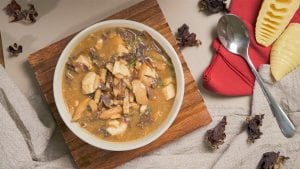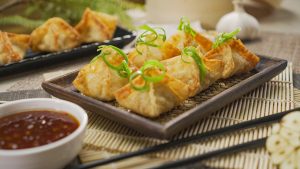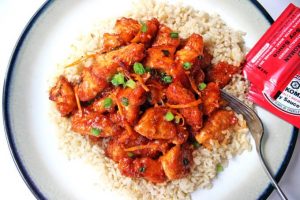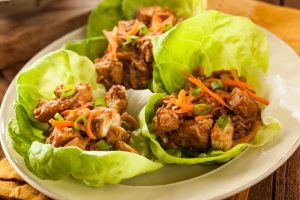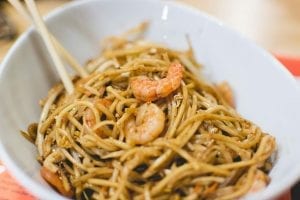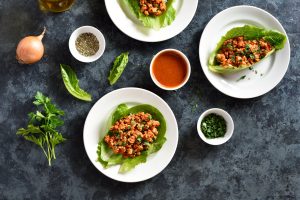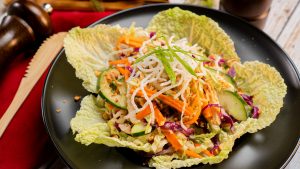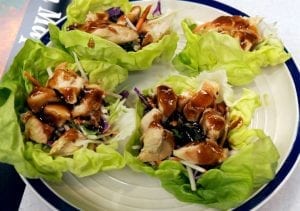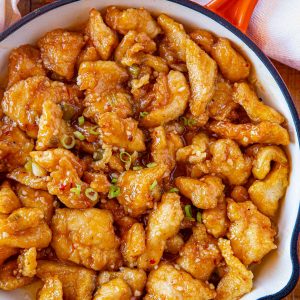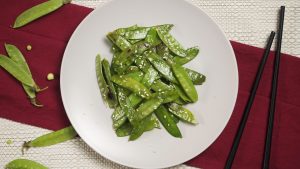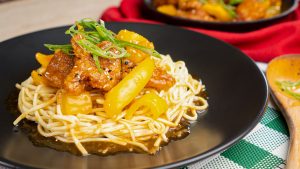If you're craving for a taste of Asian cuisine, then this P.F. Chang's style garlic noodles recipe is perfect for you. This dish is all about simplicity yet packed with robust flavors, featuring fresh Chinese noodles tossed in a savory-sweet garlic sauce. Whether you're preparing a quick dinner or looking for a new addition to your Asian-themed feast, this recipe is sure to deliver a satisfying dining experience.
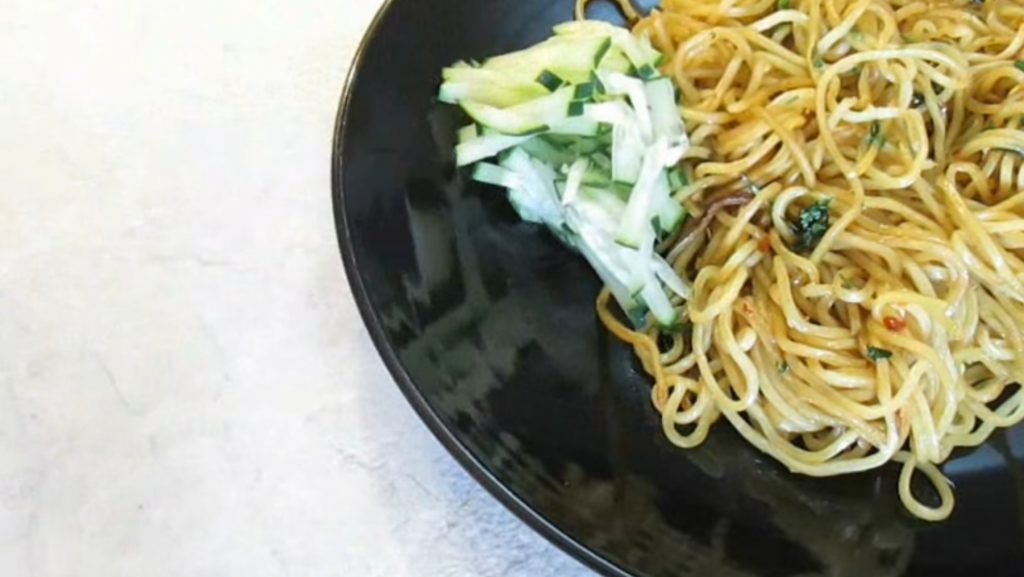
Photos of P.F. Chang’s Garlic Noodles Recipe
Some ingredients might be unfamiliar to you. Shaohsing wine, for instance, is a Chinese rice wine used in cooking to enhance the flavor. Find it in the international aisle or Asian markets. Oyster sauce, a thick, salty, and slightly sweet sauce, is commonly used in Chinese cuisine. It's available at most grocery stores. Fresh Chinese noodles are generally thicker and chewier than regular pasta. If you can't find them, just substitute with spaghetti or linguine.
Garlic Noodles Recipe Ingredients
Fresh chinese noodles: Used as the base of this dish, they are thicker and chewier in comparison to regular pasta. If you can't find them, you can substitute with spaghetti or linguine.
Canola oil: Used for frying, it has a neutral flavor that won't overpower the dish.
Garlic: An essential ingredient that gives this dish its distinct flavor.
White vinegar and sugar: These two ingredients provide a balance of sweetness and acidity to the dish.
Chicken broth: It's used to create the savory sauce for the noodles.
Red chile flakes: Adds a little heat to the dish. Adjust the amount according to your spice preference.
Shaohsing wine: A Chinese rice wine that enhances the flavor of the dish.
Oyster sauce: Provides a savory, sweet and salty flavor.
Salt: Used to enhance the flavors of the other ingredients.
Cornstarch: Helps to thicken the sauce.
Sesame oil: Gives a nutty flavor to the sauce.
Japanese cucumber and cilantro: Used as garnishes, they add fresh and crisp textures to the dish.
One reader, Brandi Murphy says:





the p.f. chang's style garlic noodles recipe is a game-changer! The flavors are so rich and the noodles are perfectly cooked. It's now a family favorite in our house. The combination of garlic, vinegar, and sesame oil is simply divine. I highly recommend trying this recipe!
Key Techniques for Perfect Garlic Noodles
Cooking the noodles: Boil the fresh Chinese noodles for a minute less than the package instructions, then drain and set aside.
Making the sauce: Heat canola oil in a large skillet over medium-high heat, then cook the garlic until fragrant. Add sugar and vinegar, then toss the noodles in the pan with the canola oil mixture and set them aside. In the same skillet, add chicken broth, chile flakes, sugar, shaohsing wine, oyster sauce, salt, cornstarch, and sesame oil. Turn the heat to high, stir to combine the sauce ingredients, and let it thicken for 20 to 30 seconds.
Julienning the cucumbers: Cut the unpeeled Japanese cucumber into ¼ inch slices on an angle, then slice them into matchsticks about ¼ inch thick.
Serving: Toss the julienned cucumbers with cilantro and serve alongside the noodles.
How To Make P.F. Chang’s Garlic Noodles
This copycat recipe for P.F. Chang’s garlic noodles will teach you how to make this takeout favorite and create a delicately flavored noodle dish.
Serves:
Ingredients
- 1lbfresh Chinese noodles
- 1tbspcanola oil
- 1tbspgarlic,minced
- 2tspsugar
- 2tspwhite vinegar
- ¾cupchicken broth
- 1tspred chile flakes
- 1tspsugar
- 2tspshaohsing wine
- 2tspoyster sauce
- ½tspsalt
- 1tspcornstarch
- ½tspsesame oil
- 1japanese cucumber,julienned on an angle
- cilantro,chopped, optional
Instructions
-
Cook the noodles a minute shy of the directions on the bag, drain and keep on a plate while making the sauce.
-
In a large skillet heat the canola oil on medium-high and cook the garlic for 20 to 30 seconds or until fragrant but not browning.
-
Add in the sugar and vinegar and stir to combine.
-
Toss the noodles in the pan with the canola oil mixture and remove them again while making the sauce.
-
Add in the chicken broth, chile flakes, sugar, shaohsing wine, oyster sauce, salt, cornstarch and sesame oil.
-
Turn the heat on the pan up to high heat.
-
Stir to combine the sauce ingredients and let it thicken in the pan for 20 to 30 seconds.
-
Add in the noodles and stir fry the noodles until the sauce is completely absorbed.
-
To julienne the cucumbers, cut them (unpeeled) into ¼ inch slices on an angle, then slice them into matchsticks about ¼ inch thick.
-
Toss with cilantro and serve.
Nutrition
- Calories: 522.78kcal
- Fat: 9.83g
- Saturated Fat: 1.87g
- Trans Fat: 0.08g
- Monounsaturated Fat: 4.15g
- Polyunsaturated Fat: 2.89g
- Carbohydrates: 90.34g
- Fiber: 4.37g
- Sugar: 7.35g
- Protein: 17.97g
- Cholesterol: 96.60mg
- Sodium: 464.27mg
- Calcium: 60.82mg
- Potassium: 469.56mg
- Iron: 4.99mg
- Vitamin A: 41.37µg
- Vitamin C: 3.89mg
Crucial Technique for Mastering P.F. Chang's Style Garlic Noodles
When stir frying the noodles in the sauce, ensure that the heat is high enough to allow the sauce to be completely absorbed. This will give the noodles a rich flavor and prevent them from becoming soggy. Also, when julienning the cucumber, use a sharp knife for precision and consistency in size. This will not only improve the presentation but also ensure even distribution of flavor.
Time-Saving Tips for Making P.F. Chang's Style Garlic Noodles
Prep ahead: Chop and measure all ingredients before starting to cook. This will streamline the cooking process and make it easier to manage multiple tasks simultaneously.
One-pot wonders: Opt for recipes that can be cooked in a single pot or pan to minimize cleanup and save time on washing dishes.
Batch cooking: Prepare larger quantities of certain components, such as sauces or grains, and store them for future use in other recipes.
Efficient tools: Utilize kitchen gadgets like food processors, mandolines, and immersion blenders to speed up prep work and cooking processes.
Time-saving ingredients: Incorporate pre-prepped items like pre-cut vegetables, canned beans, and frozen fruits to cut down on preparation time.
Substitute Ingredients For P.F. Chang’s Garlic Noodles Recipe
fresh Chinese noodles - Substitute with spaghetti noodles: Spaghetti noodles have a similar texture and can be used as a substitute for Chinese noodles in this recipe.
canola oil - Substitute with vegetable oil: Vegetable oil can be used as a substitute for canola oil as it has a neutral flavor and a similar smoke point.
garlic - Substitute with garlic powder: Garlic powder can be used as a substitute for fresh garlic, providing a similar flavor without the need for mincing or chopping.
sugar - Substitute with honey: Honey can be used as a natural sweetener instead of sugar, adding a different depth of flavor to the dish.
white vinegar - Substitute with rice vinegar: Rice vinegar can be used as a substitute for white vinegar, providing a slightly milder and sweeter flavor.
chicken broth - Substitute with vegetable broth: Vegetable broth can be used as a substitute for chicken broth, providing a similar depth of flavor.
red chile flakes - Substitute with sriracha: Sriracha can be used as a substitute for red chile flakes, adding heat and flavor to the dish.
shaohsing wine - Substitute with dry sherry: Dry sherry can be used as a substitute for shaohsing wine, providing a similar depth of flavor.
oyster sauce - Substitute with hoisin sauce: Hoisin sauce can be used as a substitute for oyster sauce, providing a sweet and savory flavor.
salt - Substitute with soy sauce: Soy sauce can be used as a substitute for salt, adding a savory umami flavor to the dish.
cornstarch - Substitute with all-purpose flour: All-purpose flour can be used as a substitute for cornstarch to thicken the sauce.
sesame oil - Substitute with peanut oil: Peanut oil can be used as a substitute for sesame oil, providing a nutty flavor to the dish.
Japanese cucumber - Substitute with English cucumber: English cucumber can be used as a substitute for Japanese cucumber, providing a similar crisp texture.
cilantro - Substitute with parsley: Parsley can be used as a substitute for cilantro, providing a fresh and herbaceous flavor.
Plating Ideas for Garlic Noodles
- Elevate the noodles: Gently twirl the noodles into a nest shape using tongs to create a visually appealing presentation on the plate.
- Garnish with cucumber and cilantro: Arrange the julienned cucumbers and fresh cilantro on top of the noodles to add a pop of color and freshness to the dish.
- Incorporate texture: Consider adding a sprinkle of toasted sesame seeds or crushed peanuts to provide a delightful crunch and visual interest.
- Utilize elegant tableware: Select beautiful, minimalist bowls or plates to showcase the dish and enhance the dining experience.
- Focus on symmetry: Arrange the components of the dish thoughtfully to create a balanced and visually pleasing composition on the plate.
- Highlight the sauce: Drizzle a small amount of the flavorful sauce around the noodles using a squeeze bottle to add a touch of finesse to the presentation.
- Consider the negative space: Embrace the beauty of simplicity by allowing some empty space on the plate to draw attention to the main elements of the dish.
Essential Kitchen Tools for Making Garlic Noodles
- Saucepan: A saucepan is a deep cooking pan with a long handle, used for cooking sauces, soups, and other liquids.
- Skillet: A skillet is a flat-bottomed pan used for frying, searing, and browning foods. It typically has a long handle and low sides.
- Colander: A colander is a bowl-shaped kitchen utensil with perforations or holes for draining liquids from food, such as pasta or vegetables.
- Whisk: A whisk is a kitchen tool used for blending, whipping, and beating ingredients, typically made of metal loops attached to a handle.
- Cutting board: A cutting board is a durable board used for cutting and preparing food. It provides a safe and stable surface for chopping and slicing.
- Chef's knife: A chef's knife is a versatile, all-purpose kitchen knife with a broad blade that is used for chopping, slicing, and dicing a variety of ingredients.
- Measuring cups and spoons: Measuring cups and spoons are essential for accurately measuring ingredients in cooking and baking recipes.
- Grater: A grater is a kitchen tool with sharp-edged holes used to shred or grate foods such as cheese, vegetables, or citrus zest.
- Tongs: Tongs are a versatile kitchen tool with two arms and a pivot, used for gripping and lifting hot or delicate foods while cooking.
- Garlic press: A garlic press is a handheld kitchen tool used to crush and mince garlic cloves, making it easier to incorporate into dishes.
- Large mixing bowl: A large mixing bowl is used for combining and mixing ingredients in recipes, such as salads, batters, and doughs.
- Wok: A wok is a versatile round-bottomed cooking pan with high, sloping sides, commonly used in Asian cooking for stir-frying, steaming, and deep-frying.
- Spatula: A spatula is a flat, flexible kitchen tool used for lifting, flipping, and spreading foods, such as pancakes, eggs, and baked goods.
- Strainer: A strainer is a kitchen utensil with a mesh or perforated surface used to separate solids from liquids or to sift dry ingredients.
- Wooden spoon: A wooden spoon is a traditional kitchen tool made of wood, used for stirring, mixing, and serving a variety of dishes.
Storing and Freezing Garlic Noodles: A Guide
Here are the storing and freezing guidelines for P.F. Chang's style garlic noodles:
- Let the noodles cool completely before storing them in an airtight container in the refrigerator. They will keep for up to 3-4 days.
- If you want to freeze the garlic noodles, place them in a freezer-safe container or resealable plastic bag. Squeeze out as much air as possible to prevent freezer burn. The noodles can be frozen for up to 2-3 months.
- When you're ready to eat the frozen noodles, let them thaw in the refrigerator overnight. You can also defrost them in the microwave, but be careful not to overheat them, as they can become mushy.
- To reheat the noodles, place them in a skillet over medium heat with a splash of chicken broth or water. Stir the noodles occasionally until they are heated through and the liquid has evaporated. You can also reheat them in the microwave, but be sure to stir them every 30 seconds to ensure even heating.
- If the noodles seem dry after reheating, you can add a little extra oyster sauce, sesame oil, or chicken broth to help moisten them and restore their flavor.
- The cucumber and cilantro garnishes are best added fresh after reheating the noodles. If you have leftover garnishes, store them separately in the refrigerator and add them just before serving.
How To Reheat Leftover Garlic Noodles
The best way to reheat leftover P.F. Chang's style garlic noodles is to use a skillet or wok on the stovetop. Heat a tablespoon of canola oil or sesame oil over medium-high heat, then add the noodles and stir-fry them for 2-3 minutes until they are heated through and slightly crispy.
Another option is to use the microwave, but be careful not to overheat the noodles as they can become rubbery. Place the noodles in a microwave-safe dish and cover them with a damp paper towel. Microwave on high for 30-second intervals, stirring in between, until the noodles are heated through.
If you want to add some extra flavor and moisture to your reheated noodles, try adding a splash of chicken broth or oyster sauce before reheating. This will help to revive the sauce and keep the noodles from drying out.
For a crispy texture, you can also reheat the noodles in the oven. Preheat your oven to 350°F (175°C), spread the noodles out on a baking sheet, and bake for 5-10 minutes until they are heated through and slightly crispy on the edges.
If you have any leftover Japanese cucumber and cilantro, chop them up and sprinkle them over the reheated noodles for a fresh and crunchy contrast to the savory garlic sauce.
Interesting Trivia About Garlic Noodles
P.F. Chang's is an American restaurant chain known for its fusion cuisine, blending traditional Chinese dishes with an American twist.
Is Making Garlic Noodles at Home Cost-Effective?
This garlic noodles recipe is quite cost-effective for a household. The ingredients, such as chinese noodles, garlic, and chicken broth, are affordable and readily available. The use of simple yet flavorful components like sesame oil and shaohsing wine adds value without significantly increasing the cost. The approximate cost for a household of 4 people is around $15, making it a budget-friendly option. Overall, this recipe earns a solid 8 for its affordability and delicious outcome.
Are Garlic Noodles Healthy or Unhealthy?
This recipe for P.F. Chang's style garlic noodles has both healthy and unhealthy aspects. On the positive side, it includes:
- Fresh Chinese noodles, which can be a good source of carbohydrates
- Garlic, known for its potential health benefits like boosting the immune system
- Cucumber, a low-calorie vegetable rich in nutrients
- Cilantro, an herb with antioxidant properties
However, there are some less healthy components:
- The use of canola oil, which is a refined oil high in omega-6 fatty acids
- Added sugars in the sauce
- Oyster sauce, which can be high in sodium
- The dish may be high in overall calories due to the noodles and sauce
To make this recipe healthier, consider the following modifications:
- Swap canola oil for a healthier option like avocado oil or olive oil
- Reduce the amount of added sugars in the sauce or use a natural sweetener like honey
- Use low-sodium chicken broth and oyster sauce to reduce the overall sodium content
- Increase the amount of vegetables in the dish, such as adding carrots, bell peppers, or bok choy
- Use whole wheat or vegetable-based noodles for added fiber and nutrients
- Control portion sizes to manage overall calorie intake
By making these adjustments, you can enjoy the flavors of P.F. Chang's garlic noodles while making the dish more nutritionally balanced. Incorporating more vegetables, reducing added sugars and sodium, and using healthier cooking oils can all contribute to a more well-rounded meal.
Editor's Opinion on P.F. Chang's Style Garlic Noodles
This recipe for P.F. Chang's style garlic noodles is a delightful combination of savory and aromatic flavors. The use of fresh Chinese noodles and the fragrant garlic create a wonderful base for the dish. The sauce, with its balance of sweet, tangy, and spicy elements, adds depth and complexity to the noodles. The addition of cucumber and cilantro provides a refreshing contrast, enhancing the overall dining experience. This dish is a perfect blend of textures and flavors, making it a delightful addition to any meal.
Enhance Your P.F. Chang’s Garlic Noodles Recipe with These Unique Side Dishes:
Similar Recipes to Try If You Love Garlic Noodles
Appetizer and Dessert Pairings for P.F. Chang's Style Garlic Noodles
Why trust this P.F. Chang’s Garlic Noodles Recipe:
This recipe is a true reflection of P.F. Chang's style garlic noodles, capturing the essence of the dish with authentic flavors and techniques. The combination of garlic, oyster sauce, and sesame oil creates a rich and savory sauce that perfectly coats the fresh Chinese noodles. The careful balance of sugar and white vinegar adds a delightful hint of sweetness and tanginess. The use of chicken broth and shaohsing wine further enhances the depth of flavors, ensuring a delicious and satisfying dining experience.
Was this page helpful?
Have your own special recipe to share? Submit Your Recipe Today!
